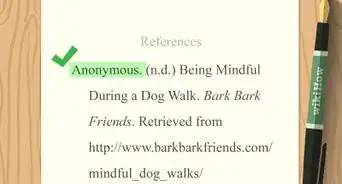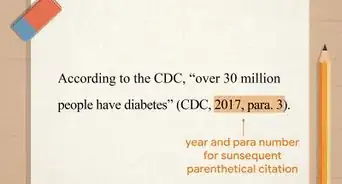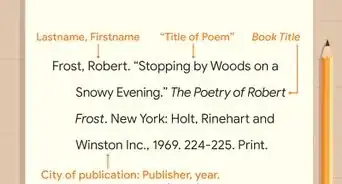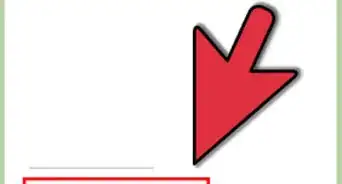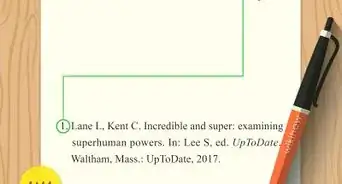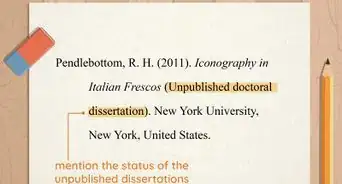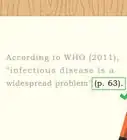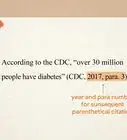This article was co-authored by wikiHow staff writer, Jennifer Mueller, JD. Jennifer Mueller is a wikiHow Content Creator. She specializes in reviewing, fact-checking, and evaluating wikiHow's content to ensure thoroughness and accuracy. Jennifer holds a JD from Indiana University Maurer School of Law in 2006.
There are 10 references cited in this article, which can be found at the bottom of the page.
This article has been viewed 69,407 times.
Learn more...
Articles and reports from the Centers for Disease Control and Prevention (CDC) are commonly used sources, particularly if you're writing a research paper about a medical or public health issue. Generally, you'll cite the CDC the same way you would cite any other government website or publication. However, your format may differ depending on whether you're using the American Psychological Association (APA), American Medical Association (AMA), Modern Language Association (MLA), or Chicago citation style.
Steps
APA
-
1Start your entry with the name of the agency. As the government agency responsible for the material, the Centers for Disease Control and Prevention is considered the author, even if an individual author is listed. Type out the full name and place a period at the end.[1]
- Example: Centers for Disease Control and Prevention.
-
2Provide the date the article or report was published or last updated. If you're using an article, it will likely have a specific publication date because it wouldn't be changed later. For webpages, however, you're more likely to use the date of the last update, since those pages are reviewed periodically. Provide as specific a date as you can in parentheses, typing the year followed by a comma, then the month and day. Do not abbreviate the names of any months. Place a period outside the closing parenthesis.[2]
- Example: Centers for Disease Control and Prevention. (2018, December 14).
Advertisement -
3Include the title in italics. Type the title in sentence case, capitalizing only the first word and any proper nouns or acronyms in the title. Place a period at the end of the title, unless the title itself has its own closing punctuation.[3]
- Example: Centers for Disease Control and Prevention. (2018, December 14). What is ADHD?
-
4Close your entry with the URL for the article or report. Start with the word "Retrieved." For pages that may be regularly updated, include the date you accessed the page in month-day-year format, followed by the word "from" and the URL. If your reference is a journal article or PDF of a report, simply provide the URL after the words "Retrieved from" without a date of access. Do not place a period at the end of the URL.[4]
- Example: Centers for Disease Control and Prevention. (2018, December 14). What is ADHD? Retrieved May 22, 2019, from https://www.cdc.gov/ncbddd/adhd/facts.html
APA Reference List Format
Centers for Disease Control and Prevention. (Year, Month Day). Title of article or page in sentence case. Retrieved Month Day, Year, from URL.
-
5Use the name of the agency and year of publication to cite in-text. Generally, APA requires a parenthetical citation at the end of any sentence in which you quote or paraphrase from a source. For a CDC citation, that parenthetical would include the full name of the CDC and the year the article or page was published or last updated. Include your parenthetical citation inside the closing punctuation for the sentence.[5]
- For example, you might write "Children with ADHD have developmental differences that cause them to have continued difficulty focusing on tasks (Centers for Disease Control and Prevention, 2018)."
- A parenthetical citation at the end of the sentence isn't necessary if you incorporate the parenthetical information in the body of your paper. For example, you might write "According to the CDC (2018), more than 6 million children have been diagnosed with ADHD."
- If you quote directly from the source, include the page number ("p.") or paragraph number ("para.") where the quoted passage appears in your citation. For example, you might write: While researchers haven't yet identified the specific causes of ADHD, the CDC notes that "genetics plays an important role" (2018, para. 5).
AMA
-
1Start your footnote with the name of the agency. The AMA uses footnotes or endnotes instead of including a reference list at the end of a paper. You only have to write the note once. All other citations to that same source will point readers to the original note number. Normally the author would be the first element of your note. However, here, the CDC is considered the author. Type the agency's name out in full and place a period at the end.[6]
- Example: Centers for Disease Control and Prevention.
-
2Include the title of the article or webpage. Type the title of the article or webpage in regular font. Use title case, capitalizing the first word and all nouns, pronouns, adjectives, adverbs, and verbs. Place a period at the end of the title.[7]
- Example: Centers for Disease Control and Prevention. Basic Information about Traumatic Brain Injury.
-
3Provide the URL and date of access. After the title, copy and paste the URL that would take your readers directly to your source. Place a period at the end of the URL. Then type the word "Accessed" followed by the date you last accessed the page in month-day-year format. Do not abbreviate the names of any months. Place a period after the year.[8]
- Example: Centers for Disease Control and Prevention. Basic Information about Traumatic Brain Injury. https://www.cdc.gov/traumaticbraininjury/basics.html. Accessed May 22, 2019.
AMA Footnote Format
Centers for Disease Control and Prevention. Title of Article or Page in Title Case. URL. Accessed Month Day, Year.
MLA
-
1Use the full name of the agency as the author of the article or page. the CDC is an agency within the Department of Health and Human Services, which is itself a department of the US government. Include each of these units in descending order from largest to smallest, separated by commas. Place a period after the final agency's name.[9]
- Example: United States, Department of Health and Human Services, Centers for Disease Control and Prevention.
-
2Provide the title of the article or page in double quotation marks. After the name of the agency, type the title of the article or page using title case. Capitalize the first word and all nouns, pronouns, adjectives, adverbs, and verbs. Place a period at the end of the title, inside the closing quotation marks.[10]
- Example: United States, Department of Health and Human Services, Centers for Disease Control and Prevention. "People at High Risk for Flu Complications."
-
3Close your Works Cited entry with publication information. Use the full name of the CDC as the publisher of the page or article followed by a comma. Then type the date of publication in day-month-year format. Abbreviate the names of months that are 4 letters or longer. Place a comma after the date, then copy and paste the URL. Do not include the "http://" portion of the URL. Place a period at the end.[11]
- Example: United States, Department of Health and Human Services, Centers for Disease Control and Prevention. "People at High Risk for Flu Complications." Centers for Disease Control and Prevention, 27 Aug. 2018, www.cdc.gov/flu/highrisk/index.htm.
MLA Works Cited Format
United States, Department of Health and Human Services, Centers for Disease Control and Prevention. "Title of Page or Article." Centers for Disease Control and Prevention, Day Month Year, URL.
-
4Omit the author's name from your entry if you're citing multiple pages. In some cases, you may be using several articles or webpages from the CDC as sources. If so, you can leave the author's name off and start your entry with the title of the article or webpage. All the rest of your Works Cited entry remains the same.[12]
- Example: "People at High Risk for Flu Complications." Centers for Disease Control and Prevention, 27 Aug. 2018, www.cdc.gov/flu/highrisk/index.htm.
Alternative MLA Works Cited Format
"Title of Page or Article." Centers for Disease Control and Prevention, Day Month Year, URL.
-
5Use the first element of your Works Cited entry for in-text citations. If your Works Cited entry lists the CDC first as the author, include the name of the agency and all the larger government units in your parenthetical in-text citation. On the other hand, if you started your entry with the title of the article, you would use a shortened version of the title. Include a page number if the source is paginated. Place the sentence's closing punctuation outside the closing parenthesis.[13]
- For example, you might write "Adults over the age of 65 are at higher risk of developing more serious flu-related complications (United States, Department of Health and Human Services, Centers for Disease Control and Prevention)."
- Even if you mention the CDC in your text, you likely still need this parenthetical because your Works Cited entry starts with "United States," not "Centers for Disease Control and Prevention." Without the parenthetical, your readers wouldn't be able to easily find the full entry in your Works Cited.
Chicago
-
1List the full title of the agency as the author. Because the CDC is part of the Department of Health and Human Services, list the larger department first. Place a period after the name of the department. Then, type out the full name of the CDC, also followed by a period.[14]
- Example: U.S. Department of Health and Human Services. Centers for Disease Control and Prevention.
-
2Provide the title of the page or article in italics. After the name of the agency, type the full title of the article. Use title case, capitalizing the first word and all nouns, pronouns, adjectives, adverbs, and verbs. Place a period at the end of the title.[15]
- Example: U.S. Department of Health and Human Services. Centers for Disease Control and Prevention. Strategies to Prevent Obesity.
-
3Add publication information for the page or article. Since the CDC is located in Atlanta, use that city as the location where the article or webpage was published. The publisher is considered the U.S. Department of Health and Human Services, of which the CDC is a part. Place a comma after the name of the department, then add the year the source was published or last updated. Place a period after the year.[16]
- Example: U.S. Department of Health and Human Services. Centers for Disease Control and Prevention. Strategies to Prevent Obesity. Atlanta: U.S. Department of Health and Human Services, 2015.
-
4Close your bibliography entry with the URL. The URL is the last element of your bibliography entry. Copy the full, direct URL or permalink and paste it at the end of your entry. Place a period at the end of the URL.[17]
- Example: U.S. Department of Health and Human Services. Centers for Disease Control and Prevention. Strategies to Prevent Obesity. Atlanta: U.S. Department of Health and Human Services, 2015. https://www.cdc.gov/obesity/strategies/index.html.
Chicago Bibliography Format
U.S. Department of Health and Human Services. Centers for Disease Control and Prevention. Title of Page or Article. Atlanta: U.S. Department of Health and Human Services, Year. URL.
-
5Adjust your punctuation for footnotes in-text. Chicago style uses footnotes as in-text citations whenever you quote or paraphrase from a research source. While the footnote contains the same information as your bibliographic entry, the punctuation changes because a footnote is formatted like a sentence. The only period occurs at the end of the footnote. Other elements are separated by commas, with the publication information enclosed in parentheses.[18]
- Example: U.S. Department of Health and Human Services, Centers for Disease Control and Prevention, Strategies to Prevent Obesity (Atlanta: U.S. Department of Health and Human Services, 2015), https://www.cdc.gov/obesity/strategies/index.html.
References
- ↑ https://academicguides.waldenu.edu/writingcenter/apa/citations/commonsources
- ↑ http://libguides.scf.edu/c.php?g=447371&p=3075453
- ↑ https://libguides.regiscollege.edu/c.php?g=977470&p=7067582
- ↑ https://libguides.regiscollege.edu/c.php?g=977470&p=7067582
- ↑ http://libguides.scf.edu/c.php?g=447371&p=3075453
- ↑ http://mdanderson.libanswers.com/faq/26256
- ↑ http://mdanderson.libanswers.com/faq/26256
- ↑ https://guides.library.uab.edu/citation/ama
- ↑ https://www.nwtc.edu/NWTC/media/student-experience/Library/MLA-Citation-Handout.pdf
- ↑ https://utica.libguides.com/c.php?g=703243&p=4991664
- ↑ https://utica.libguides.com/c.php?g=703243&p=4991664
- ↑ https://www.nwtc.edu/NWTC/media/student-experience/Library/MLA-Citation-Handout.pdf
- ↑ https://irsc.libguides.com/c.php?g=483085&p=3303421
- ↑ https://owl.purdue.edu/owl/research_and_citation/chicago_manual_17th_edition/cmos_formatting_and_style_guide/web_sources.html
- ↑ https://www.chicagomanualofstyle.org/tools_citationguide/citation-guide-1.html
- ↑ https://www.chicagomanualofstyle.org/tools_citationguide/citation-guide-1.html
- ↑ https://owl.purdue.edu/owl/research_and_citation/chicago_manual_17th_edition/cmos_formatting_and_style_guide/web_sources.html
- ↑ https://www.chicagomanualofstyle.org/tools_citationguide/citation-guide-1.html
-Step-1.webp)
-Step-2.webp)
-Step-3.webp)
-Step-4.webp)
-Step-5.webp)
-Step-6.webp)
-Step-7.webp)
-Step-8.webp)
-Step-9.webp)
-Step-10.webp)
-Step-11.webp)
-Step-12.webp)
-Step-13.webp)
-Step-14.webp)
-Step-15.webp)
-Step-16.webp)
-Step-17.webp)
-Step-18.webp)
